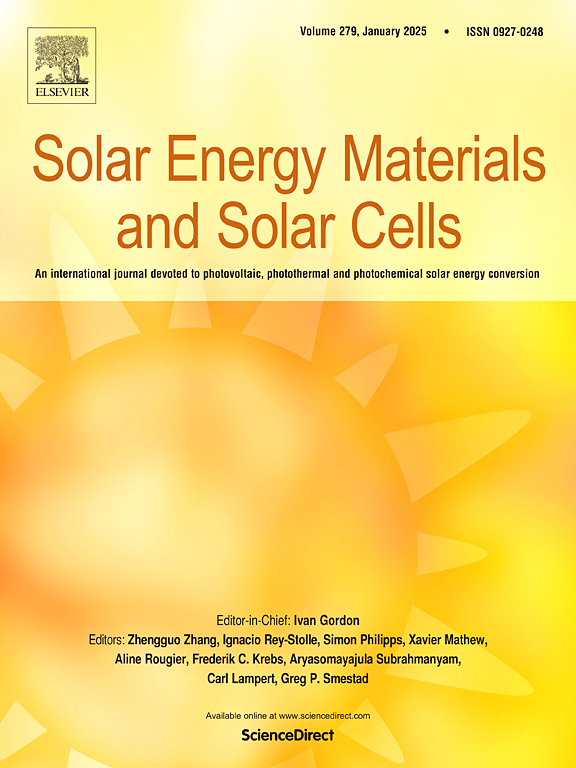Passive radiative cooling films doped with SiO2-TiO2 of different particle sizes with excellent solar reflectivity and high infrared emissivity
IF 6.3
2区 材料科学
Q2 ENERGY & FUELS
引用次数: 0
Abstract
Energy transfer to outer space through thermal radiation is a passive cooling method that consumes no energy. For more efficient utilization of radiative cooling in thermal management applications, surfaces should be designed with excellent solar reflectance and high selective emissivity. A composite cooling film (SiTiP) with excellent solar reflectivity and high infrared emissivity was prepared by doping polyvinylidene difluoride (PVDF) with silicon dioxide (SiO2) and titanium dioxide (TiO2) particles of different sizes. The incorporation of SiO2 and TiO2 enhanced the Mie scattering, resulting in SiTiP achieving a solar reflectance of 91.16 % (maximum reflectivity of 99.21 %). The average emissivity of the SiTiP within 8–13 μm was 91.41 %, and the maximum emissivity reached 94.22 %. During the indoor simulated test, the SiTiP achieved a temperature reduction of up to 7.47 °C. During the outdoor test, the maximum temperature reduction reached 7.92 °C. The temperature in the area sheltered by SiTiP was reduced by 25.5 °C compared to the exposed bicycle seat. This study presents a cost-effective and scalable method for fabricating high performance radiative cooling films, which offer promising solutions for the energy efficient cooling of car, buildings, and solar cells.
掺杂不同粒径SiO2-TiO2的被动辐射冷却膜具有优异的太阳反射率和高红外发射率
通过热辐射向外太空传递能量是一种不消耗能量的被动冷却方法。为了在热管理应用中更有效地利用辐射冷却,表面应设计具有优异的太阳反射率和高选择性发射率。采用不同尺寸的二氧化硅(SiO2)和二氧化钛(TiO2)颗粒掺杂聚偏二氟乙烯(PVDF)制备了具有优良太阳反射率和高红外发射率的复合冷却膜(SiTiP)。SiO2和TiO2的掺入增强了Mie散射,使得SiTiP的太阳反射率达到91.16%(最大反射率为99.21%)。SiTiP在8 ~ 13 μm范围内的平均发射率为91.41%,最大发射率为94.22%。在室内模拟测试中,SiTiP实现了高达7.47°C的温度降低。在室外测试中,最大温度降低达到7.92°C。与暴露的自行车座椅相比,SiTiP遮蔽区域的温度降低了25.5°C。本研究提出了一种具有成本效益且可扩展的制造高性能辐射冷却膜的方法,为汽车,建筑物和太阳能电池的节能冷却提供了有前途的解决方案。
本文章由计算机程序翻译,如有差异,请以英文原文为准。
求助全文
约1分钟内获得全文
求助全文
来源期刊

Solar Energy Materials and Solar Cells
工程技术-材料科学:综合
CiteScore
12.60
自引率
11.60%
发文量
513
审稿时长
47 days
期刊介绍:
Solar Energy Materials & Solar Cells is intended as a vehicle for the dissemination of research results on materials science and technology related to photovoltaic, photothermal and photoelectrochemical solar energy conversion. Materials science is taken in the broadest possible sense and encompasses physics, chemistry, optics, materials fabrication and analysis for all types of materials.
 求助内容:
求助内容: 应助结果提醒方式:
应助结果提醒方式:


